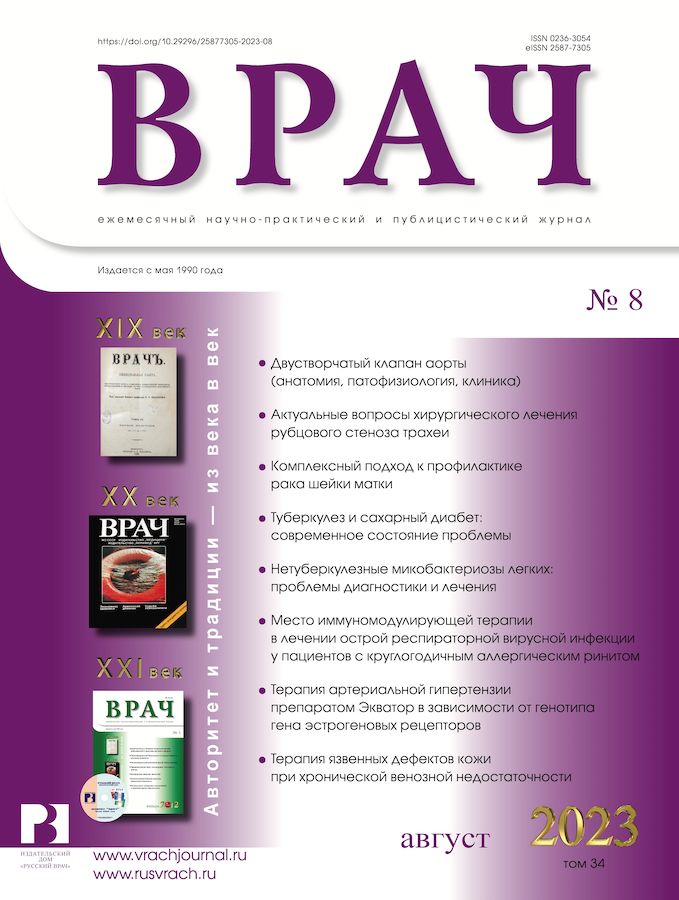Efficiency of application of virtual reality technologies and mechanotherapy with biofeedback in increasing tolerance to physical loads in patients with post-COVID disorders syndrome
- Authors: Ansokova M.A.1, Marchenkova L.A.1, Vershinin A.A.1, Fesyun A.D.1, Yurova O.V.1
-
Affiliations:
- National Medical Research Center for Rehabilitation and Balneology, Ministry of Health of Russia
- Issue: Vol 34, No 8 (2023)
- Pages: 59-62
- Section: From Practice
- URL: https://journals.eco-vector.com/0236-3054/article/view/569080
- DOI: https://doi.org/10.29296/25877305-2023-08-11
- ID: 569080
Cite item
Abstract
Objective. To investigate the effectiveness of the use of mechanotherapy and virtual reality technologies in increasing physical endurance and eliminating dyspnea during the rehabilitation of patients with post-COVID disorders syndrome (PCDS).
Material and methods. The study included 120 patients who underwent a new coronavirus infection COVID-19, aged 40 to 70 years, with manifestations of PCDS. Patients of the main group (n=60) were assigned 10 sessions on a robotic simulator with biofeedback for training the muscles of the lower extremities, 10 sessions of interactive balance therapy and 10 sessions on an interactive rehabilitation system with virtual reality technology against the background of basic treatment. In the control group (n=60), patients received only basic treatment. The effectiveness of rehabilitation was assessed according to cardiopulmonary testing and the severity of dyspnea.
Results. According to cardiopulmonary testing after completion of rehabilitation in the main group, an increase in the maximum work performed by 12.9% (p=0.001 compared with the baseline, p=0.006 compared with the control) and oxygen consumption of the first ventilation threshold by 6.3% (p=0.022 and p=0.016, respectively), a decrease in diastolic blood pressure (BP) at rest by 5 mm Hg. Art. (p=0.044 and p=0.01, respectively) and at the peak of the load - by 7 mm Hg. Art. (p=0.003 and p=0.037, respectively). The level of systolic blood pressure at rest after completion of rehabilitation was 3 mm Hg. Art. lower than in control (p=0.02). In the main group, after rehabilitation, there was no severe and very severe dyspnea (0% in each case, p = 0.029 compared with the baseline), the proportion of people with moderate dyspnea decreased from 61.7% to 13.3% (p< 0.001) and increased the proportion of patients with no dyspnea (from 8.3% to 26.7%, p=0.009) or mild dyspnea (from 13.3% to 60.0%, p<0.001)
Conclusion. The use of virtual reality technologies and mechanotherapy in the framework of medical rehabilitation programs for patients who have undergone COVOD-19 contributes to an increase in exercise tolerance, a decrease in the severity of hypoxic syndrome, shortness of breath, and an improvement in cardiovascular performance in patients with PCDS.
Full Text
About the authors
M. A. Ansokova
National Medical Research Center for Rehabilitation and Balneology, Ministry of Health of Russia
Email: marchenkovala@nmicrk.ru
ORCID iD: 0000-0001-8888-6149
Russian Federation, Moscow
L. A. Marchenkova
National Medical Research Center for Rehabilitation and Balneology, Ministry of Health of Russia
Author for correspondence.
Email: marchenkovala@nmicrk.ru
ORCID iD: 0000-0003-1886-124X
MD
Russian Federation, MoscowA. A. Vershinin
National Medical Research Center for Rehabilitation and Balneology, Ministry of Health of Russia
Email: marchenkovala@nmicrk.ru
ORCID iD: 0000-0002-5734-9903
Russian Federation, Moscow
A. D. Fesyun
National Medical Research Center for Rehabilitation and Balneology, Ministry of Health of Russia
Email: marchenkovala@nmicrk.ru
ORCID iD: 0000-0003-3097-8889
MD, Associate Professor
Russian Federation, MoscowO. V. Yurova
National Medical Research Center for Rehabilitation and Balneology, Ministry of Health of Russia
Email: marchenkovala@nmicrk.ru
ORCID iD: 0000-0001-7626-5521
MD, Professor
Russian Federation, MoscowReferences
- Moreno-Pérez O., Merino E., Leon-Ramirez J.M. et al. COVID19-ALC research group. Post-acute COVID-19 syndrome. Incidence and risk factors: A Mediterranean cohort study. J Infect. 2021; 82 (3): 378–83. doi: 10.1016/j.jinf.2021.01.004
- Halpin S.J., McIvor C., Whyatt G. et al. Postdischarge symptoms and rehabilitation needs in survivors of COVID-19 infection: A cross-sectional evaluation. J Med Virol. 2021; 93 (2): 1013–22. doi: 10.1002/jmv.26368
- Carvalho-Schneider C., Laurent E., Lemaignen A. et al. Follow-up of adults with noncritical COVID-19 two months after symptom onset. Clin Microbiol Infect. 2021; 27 (2): 258–63. doi: 10.1016/j.cmi.2020.09.052
- Wang D., Hu B., Hu C. et al. Clinical characteristics of 138 hospitalized patients with 2019 novel coronavirus-infected pneumonia in Wuhan, China. JAMA. 2020; 323: 1061–9. doi: 10.1001/jama.2020.1585
- Амбражук И.И., Фесюн А.Д. Основные аспекты развития медицинской реабилитации. Russian Journal of Rehabilitation Medicine. 2018; 4: 31–6 [Ambrazhuk I.I., Fesyun A.D. The main aspects of the development of medical rehabilitation. Russian Journal of Rehabilitation Medicine. 2018; 4: 31–6 (in Russ.)].
- Guedj E., Campion J.Y., Dudouet P. et al. 18F-FDG brain PET hypometabolism in patients with long COVID. Eur J Nucl Med Mol Imaging. 2021; 8 (9): 2823–33. doi: 10.1007/s00259-021-05215-4
- Carfi A., Bernabei R., Landi F. Persistent symptoms in patients after acute COVID-19. JAMA. 2020; 324: 603–5. doi: 10.1001/jama.2020.12603
- Tenforde M.W., Kim S.S., Lindsell C.J. et al. Symptom duration and risk factors for delayed return to usual health among outpatients with COVID-19 in a multistate health care systems network: United States, March–June 2020. MMWR Morb Mortal Wkly Rep. 2020; 69: 993–8. doi: 10.15585/mmwr.mm6930e1
- van der Palen J. Concerns regarding a suggested long COVID paradigm. Lancet Respir Med. 2023; 11 (4): e34. doi: 10.1016/S2213-2600(23)00095-4
- Venturelli, S., Benatti S.V., Casati M. et al. Surviving COVID-19 in Bergamo province: a post-acute outpatient re-evaluation. Epidemiol Infect. 2021; 149: e32. doi: 10.1017/s0950268821000145
- Wong M.C., Huang J., Wong Y.Y. et al. Epidemiology, Symptomatology, and Risk Factors for Long COVID Symptoms: Population-Based, Multicenter Study. JMIR Public Health Surveill. 2023; 9: e42315. doi: 10.2196/42315
- Zhao H.M., Xie Y.X., Wang C. Recommendations for respiratory rehabilitation in adults with COVID-19. Chin Med J (Engl). 2020; 133: 1595–602. doi: 10.1097/cm9.0000000000000848
- Дедов Д.В. Новая коронавирусная инфекция: клинико-патогенетические аспекты, профилактика, значение витаминов и микроэлементов. Врач. 2022; 33 (2): 47–9 [Dedov D.V. New coronavirus infection: clinical and pathogenetic aspects, prevention, importance of vitamins and trace elements. Vrach. 2022; 33 (2): 47–9 (in Russ.)]. doi: 10.29296/25877305-2022-02-07
Supplementary files






